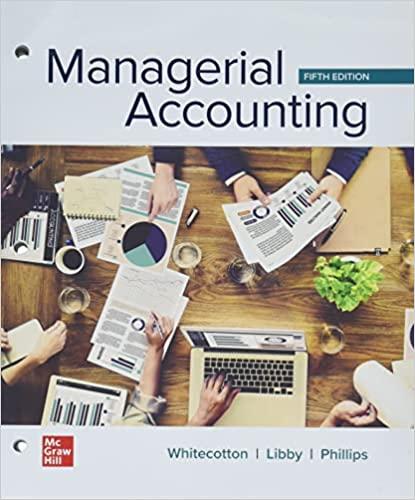





Sales-Related and Purchase-Related Transactions for Seller and Buyer Using Perpetual Inventory System The following selected transactions were completed during April between Swan Company and Bird Company: Apr.2. Swan Company sold merchandise on account to Bird Company, $19,400, terms FOB shipping point, 1/10, n/30. Swan Company paid freight of $480, which was added to the invoice. The cost of the merchandise sold was $12,200. 8. Swan Company sold merchandise on account to Bird Company, $30,000, terms FOB destination, 2/15, n/30. The cost of the merchandise sold was $18,000. 8. Swan Company paid freight of $610 for delivery of merchandise sold to Bird Company on April 8 12. Bird Company paid Swan Company for purchase of April 2 18. Swan Company paid Bird Company a refund of $2,000 for defective merchandise in the April 2 purchase. Bird Company agreed to keep the merchandise. 23. Bird Company paid Swan Company for purchase of April 8. 24. Swan Company sold merchandise on account to Bird Company, $12,000, terms FOB shipping point, n/45. The cost of the merchandise sold was $7,200. 26. Bird Company paid freight of $390 on April 24 purchase from Swan Company. 30. Swan Company granted a customer allowance (credit memo) to Bird Company for $11,300 for merchandise that was returned from the August 24 purchase. The cost of the merchandise returned was $6,500 1. Journalize the April transactions for Bird Company (the buyer) Date Credit Account Debit Apr. Merchandise Inventory 2 Accounts Payable-Swan Company Date Debit Credit Account Apr.Merchandise Inventory 8 Accounts Payable-Swan Company Credit Debit Date Account Accounts Payable-Swan Company Apr. 12 Cash Date Debit Credit Account Apr. Cash 18 Merchandise Inventory Date Credit Debit Account Apr. 23 Date Debit Credit Account Apr. 24 Date Debit Credit Account Apr. 8- sale Date Debit Credit Account Apr. 8- cost Debit Credit Date Account Apr. 8- freight Debit Credit Date Account Apr. 12 Date Debit Credit Account Apr. 18 cc Date Debit Credit Account Apr. 23 Date Debit Credit Account Apr. 24- sale Date Debit Credit Account Apr. 24- cost Date Debit Credit Account Apr. 30 Date Debit Credit Account Apr. 30 Feedback Check My Work General hint: Journalize Swan Company transactions from the seller's point of view and Bird Company transactions from the buyer's point of view. Apr. 2. Seller - FOB shipping point freight is the buyer's cost. Since it is prepaid by the seller in order for the carrier to deliver the goods, it will increase the receivable from the buyer. In addition, two other entries are required for: (1) the sale on account and (2) the cost of the merchandise sold and inventory decrease on the seller's records. Buyer - Using the perpetual inventory system, purchases of inventory on account are recorded by debiting the merchandise inventory account and crediting the accounts payable account. Added freight expense increases the cost of the merchandise. Apr. 8. (1) Seller - Two entries are required for: (1) the sale on account and (2) the cost of the merchandise sold and inventory decrease on the seller's records. (2) Buyer - Using the perpetual inventory system, purchases of inventory on account are recorded by increasing both the merchandise inventory account and the accounts payable account. Apr. 8. Seller - Recall that FOB shipping point freight is the buyer's cost, while FOB destination freight is the seller's expense. Often freight must be prepaid for the carrier to deliver. The problem does not indicate that this is to be billed to the buyer. Buyer-Not applicable Apr. 12. (1) Selling company - Under the perpetual system, the Sales Returns and Allowances account is debited while the credit is applied to the buyer's Accounts Receivable. A second entry increases Merchandise Inventory and reduces the Cost of Merchandise Sold for the return cost. (2) Buying company - Using the perpetual inventory system, any return is recorded directly by the buyer who debits Accounts Payable and credits Merchandise Inventory, basically reversing what was done in recording the purchase. Apr. 12. (1) Seller: Since the invoice was paid within the discount period, the seller deducts 2% of the invoice amount and records it as a debit to Sales Discount, while crediting Accounts Receivable for the total amount of the invoice. The difference between these two accounts is recorded as a debit to Cash. (2) Buyer: The amount paid by the buyer is the sales less discounts. Freight is not eligible for a discount. Apr. 23. (1) Seller: The return of merchandise reduces the original invoice amount paid by the buyer. The discount is taken on the amount owed on the merchandise after the return. (2) Buyer: Since the invoice is paid within the discount period, a discount is recorded by crediting Merchandise Inventory. The cash paid on account is the difference between the invoice and the discount. General hint: FOB shipping point freight is the buyer's cost, while FOB destination freight is the seller's expense. Apr. 24. Seller: Two entries are required for: (1) the sale on account and (2) the cost of the merchandise sold and inventory decrease on the seller's records. Buyer: Using the perpetual inventory system, purchases of inventory on account are recorded by increasing both the merchandise inventory account and the accounts payable account. | Apr. 26. Seller: Not applicable Buyer: Payment of freight expense is added to the cost of the merchandise and prepaid in cash. Apr. 30. (1) Seller & (2) Buyer: Since no discounts are allowed on this transaction, the cash paid on account in each case is equal to the invoice and reduces the Accounts Receivable for the seller and the Accounts Payable for the buyer












